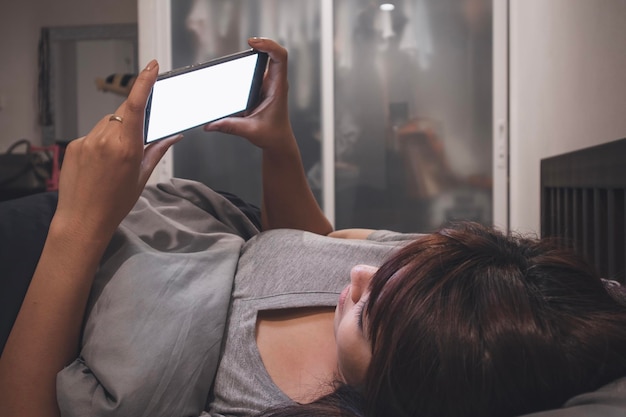Smartphone Addiction: How It Impacts Your Mental Health & Wallet

Smartphone addiction can significantly impact mental well-being, leading to increased stress, anxiety, and depression, while also causing financial strain through data usage, app purchases, and the constant urge to upgrade devices.
Are you constantly glued to your smartphone, feeling anxious when you’re not connected? Is Your Smartphone Addiction Costing You More Than Just Money? Understand the Mental Health Impact it can have on your life and how to break free from this digital dependency.
The Allure and Grip of Smartphones
Smartphones have become indispensable tools, seamlessly integrated into our daily lives. They offer instant communication, access to endless information, and a plethora of entertainment options. However, this constant connectivity can lead to a dangerous addiction, blurring the lines between convenience and dependence.
The allure of smartphones lies in their ability to provide instant gratification. Social media platforms deliver immediate feedback in the form of likes and comments, while games offer a sense of accomplishment and escape. This constant stream of rewards can trigger the release of dopamine, a neurotransmitter associated with pleasure and motivation, reinforcing addictive behaviors.
The Psychology of Smartphone Addiction
Understanding the psychological mechanisms behind smartphone addiction is crucial for recognizing and addressing the problem. The fear of missing out (FOMO) drives many users to compulsively check their phones, fearing they will be excluded from social events or important information. This constant need to stay connected can lead to anxiety and stress.
- Instant Gratification: Smartphones provide immediate rewards, such as likes, notifications, and entertaining content, leading to dopamine release and reinforcing addictive behaviors.
- Fear of Missing Out (FOMO): The anxiety that others are having rewarding experiences from which one is absent drives compulsive phone checking and social media use.
- Social Comparison: Social media often presents idealized versions of reality, leading to feelings of inadequacy and low self-esteem as users compare themselves to others.
Beyond the psychological factors, social comparison also plays a significant role. Social media platforms often showcase curated and idealized versions of reality, leading users to compare themselves to others and experience feelings of inadequacy and low self-esteem. This constant exposure to perceived perfection can negatively impact mental well-being.
Mental Health Consequences of Smartphone Addiction
The excessive use of smartphones can have profound and detrimental effects on mental health. While smartphones offer numerous benefits, their addictive potential can contribute to a range of psychological problems, including anxiety, depression, and sleep disturbances.
Studies have shown a strong correlation between smartphone addiction and increased levels of anxiety and depression. The constant barrage of notifications, the pressure to stay connected, and the fear of missing out can create a state of chronic stress. This prolonged stress can disrupt the body’s natural hormonal balance, leading to mood swings, irritability, and difficulty concentrating.

Anxiety and Depression
Smartphones can exacerbate symptoms of anxiety and depression through various mechanisms. The constant connectivity can lead to a feeling of being overwhelmed and unable to disconnect from work or social obligations. This can create a sense of pressure and obligation, contributing to anxiety. Additionally, the exposure to negative content, such as cyberbullying or distressing news, can trigger feelings of sadness and despair, worsening depressive symptoms.
- Increased Stress Levels: Constant connectivity and the pressure to stay updated can lead to chronic stress and anxiety.
- Exacerbation of Depression: Exposure to negative content and social comparison on social media can worsen symptoms of depression.
- Disrupted Sleep Patterns: The blue light emitted by smartphones can interfere with melatonin production, leading to insomnia and poor sleep quality.
Furthermore, smartphone addiction can disrupt sleep patterns. The blue light emitted by smartphone screens can interfere with the production of melatonin, a hormone that regulates sleep. This can lead to insomnia, poor sleep quality, and daytime fatigue, which can further exacerbate mental health problems.
Financial Implications of Excessive Smartphone Use
Beyond the mental health consequences, smartphone addiction can also have significant financial implications. From increased data usage to impulse purchases, the costs associated with excessive smartphone use can quickly add up. Moreover, the constant desire to upgrade to the latest model can create a cycle of financial strain.
One of the most direct financial costs of smartphone addiction is increased data usage. Streaming videos, playing online games, and browsing social media can quickly consume data, leading to overage charges or the need to purchase more expensive data plans. These recurring costs can significantly impact a household budget.
Hidden Costs and Impulse Purchases
In addition to data charges, smartphone addiction can lead to hidden costs and impulse purchases. Many apps and games offer in-app purchases, tempting users to spend money on virtual items or premium features. These small purchases can quickly accumulate, leading to unexpected expenses. Furthermore, the constant exposure to advertisements and targeted promotions on social media can trigger impulse purchases, further straining finances.
- Increased Data Usage: Streaming, gaming, and social media can lead to high data consumption and expensive overage charges.
- In-App Purchases: Addictive apps and games often include in-app purchases that can quickly deplete funds.
- Frequent Upgrades: The desire for the latest technology can lead to a cycle of expensive smartphone upgrades.
The desire to stay up-to-date with the latest technology can also lead to frequent smartphone upgrades. The allure of new features, improved cameras, and faster processors can drive users to replace their phones more often than necessary. This constant cycle of upgrades can be a significant financial burden, especially when combined with other expenses.
Recognizing the Signs of Smartphone Addiction
Recognizing the signs of smartphone addiction is the first step towards addressing the problem. While it’s normal to use smartphones frequently, certain behaviors can indicate a more serious dependency. Awareness of these signs can help individuals and their loved ones identify potential issues and seek help.
One of the most common signs of smartphone addiction is spending excessive amounts of time on the device. This can manifest as constantly checking notifications, scrolling through social media, or playing games for hours on end. Individuals may lose track of time and neglect other important activities, such as work, school, or social interactions.

Key Indicators of Dependence
Experiencing withdrawal symptoms when unable to use the phone is another key indicator of dependence. These symptoms can include anxiety, irritability, restlessness, and difficulty concentrating. Individuals may feel a strong urge to check their phone and become agitated or frustrated when they cannot. This is similar to the withdrawal symptoms experienced with other addictive substances.
- Excessive Time Spent on the Phone: Spending hours daily on the phone, neglecting other responsibilities and activities.
- Withdrawal Symptoms: Experiencing anxiety, irritability, or restlessness when unable to use the phone.
- Neglecting Responsibilities: Prioritizing phone use over work, school, or social commitments.
Neglecting responsibilities is another sign of smartphone addiction. Individuals may prioritize phone use over work, school, or social commitments. They may miss deadlines, skip classes, or cancel plans with friends and family in order to spend more time on their devices. This can lead to conflicts in relationships and negative consequences in other areas of life.
Strategies for Breaking Free from Smartphone Addiction
Breaking free from smartphone addiction requires a conscious effort and a strategic approach. While it may seem daunting, there are many effective techniques that can help individuals regain control over their device usage and improve their overall well-being. These strategies involve setting limits, creating healthy habits, and seeking support when needed.
One of the most effective strategies is to set limits on smartphone usage. This can involve using built-in features on smartphones to track and restrict screen time. Many smartphones offer tools that allow users to set daily or weekly limits on specific apps or overall usage. These features can help individuals become more aware of their habits and make conscious choices about how they spend their time.
Practical Steps to Reduce Dependence
Creating healthy habits is also essential for breaking free from smartphone addiction. This can involve replacing excessive phone use with alternative activities, such as exercise, reading, or spending time with loved ones. Engaging in activities that provide enjoyment and fulfillment can help reduce the urge to compulsively check the phone. Additionally, creating phone-free zones, such as the bedroom or dining table, can help establish boundaries and promote healthier habits.
- Setting Usage Limits: Using built-in smartphone features to track and restrict screen time.
- Creating Phone-Free Zones: Designating areas at home where phone use is prohibited, such as the bedroom or dining table.
- Engaging in Alternative Activities: Replacing phone use with hobbies, exercise, or social interactions.
Seeking support from friends, family, or a therapist can also be beneficial. Talking to others about the challenges of smartphone addiction can provide encouragement and accountability. Therapists can offer guidance and support in developing coping strategies and addressing any underlying mental health issues that may be contributing to the addiction.
Promoting a Healthier Relationship with Technology
The goal is not to eliminate technology from our lives but to promote a healthier relationship with it. Technology can be a valuable tool when used mindfully and intentionally. By setting boundaries, practicing self-awareness, and prioritizing mental well-being, individuals can harness the benefits of technology without succumbing to its addictive potential.
Mindful smartphone use involves being present and intentional with how we use our devices. This means paying attention to our motivations for using the phone and avoiding mindless scrolling. By asking ourselves why we are reaching for our phone, we can make conscious choices about whether or not it aligns with our goals and values.
Cultivating Mindful Tech Habits
Prioritizing mental well-being is also crucial for maintaining a healthy relationship with technology. This involves taking breaks from screens, engaging in activities that promote relaxation and stress reduction, and seeking support when needed. By prioritizing our mental health, we can reduce our vulnerability to smartphone addiction and cultivate a more fulfilling life.
- Practicing Mindful Usage: Being present and intentional with smartphone use, avoiding mindless scrolling.
- Setting Boundaries: Establishing time limits and phone-free zones to create a healthier balance.
- Prioritizing Mental Well-being: Taking breaks from screens and engaging in activities that promote relaxation and stress reduction.
Setting boundaries is also essential for promoting a healthy relationship with technology. This can involve establishing time limits for phone use, creating phone-free zones, and turning off notifications. By setting boundaries, we can create a greater sense of control over our technology use and protect our mental and emotional well-being.
| Key Point | Brief Description |
|---|---|
| 📱 Mental Health Impact | Addiction can lead to anxiety, depression, and disrupted sleep. |
| 💸 Financial Strain | Increased data usage, in-app purchases, and frequent upgrades can drain finances. |
| ⏰ Recognizing Addiction | Signs include excessive use, withdrawal symptoms, and neglecting responsibilities. |
| 🌱 Healthier Habits | Set usage limits, create phone-free zones, and engage in alternative activities. |
Frequently Asked Questions
▼
Main signs include spending excessive time on your phone, experiencing withdrawal symptoms when not using it, and neglecting responsibilities due to phone use.
▼
It can increase stress, anxiety, and depression levels due to constant connectivity, fear of missing out, and exposure to negative content on social media.
▼
Set usage limits, create phone-free zones in your home, engage in alternative activities, and turn off unnecessary notifications to reduce temptation.
▼
Be mindful of your phone usage from the start, set boundaries early, and prioritize real-life interactions over virtual ones. Educate yourself on the risks.
▼
Yes, by using it mindfully, setting boundaries, and prioritizing mental well-being you can have a balanced and healthy relationship with your smartphone.
Conclusion
In conclusion, understanding the impact of smartphone addiction on both your mental health and financial well-being is crucial for fostering a balanced and fulfilling life. By recognizing the signs of addiction and implementing practical strategies, you can regain control over your device usage and prioritize your overall well-being.